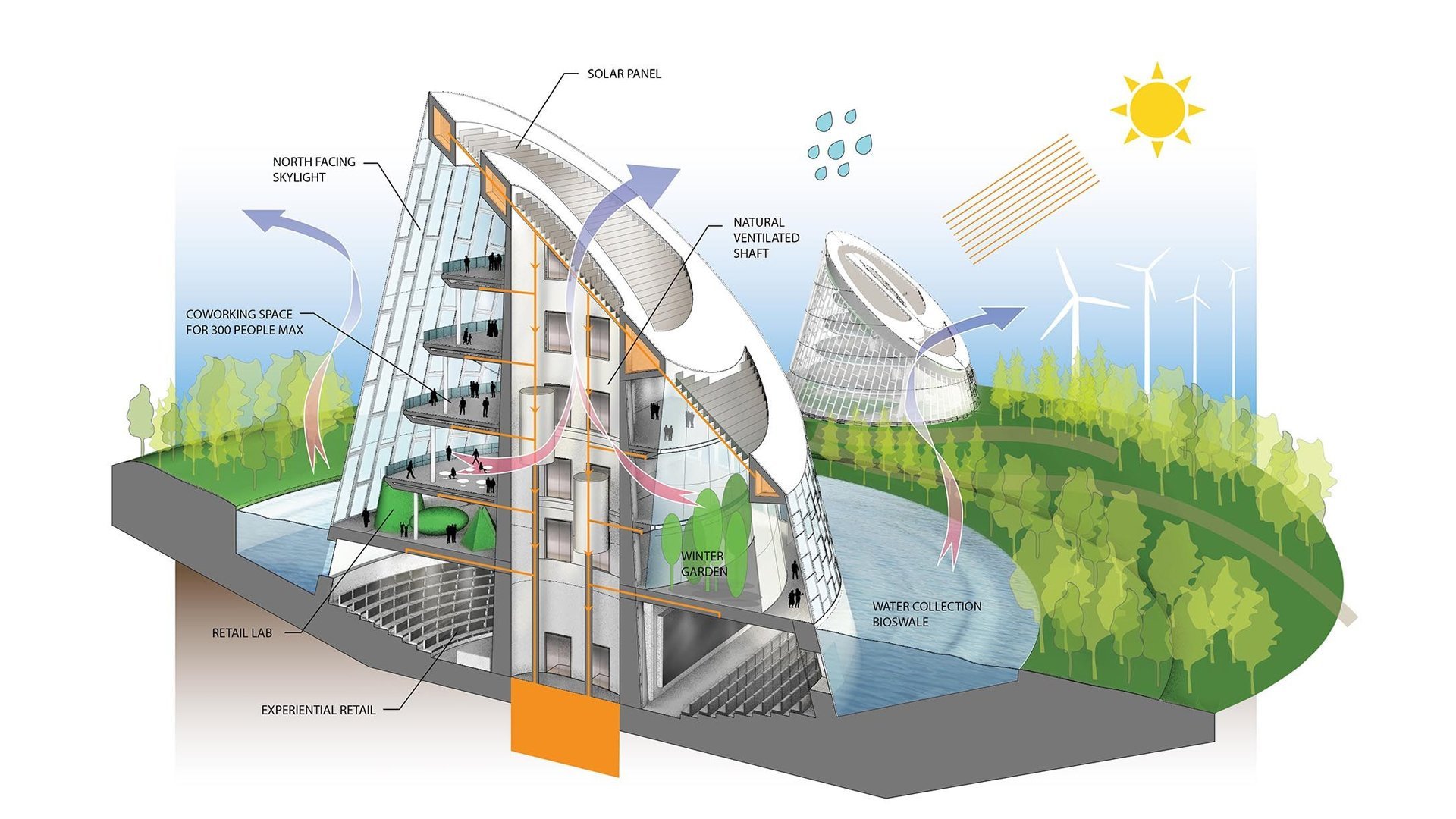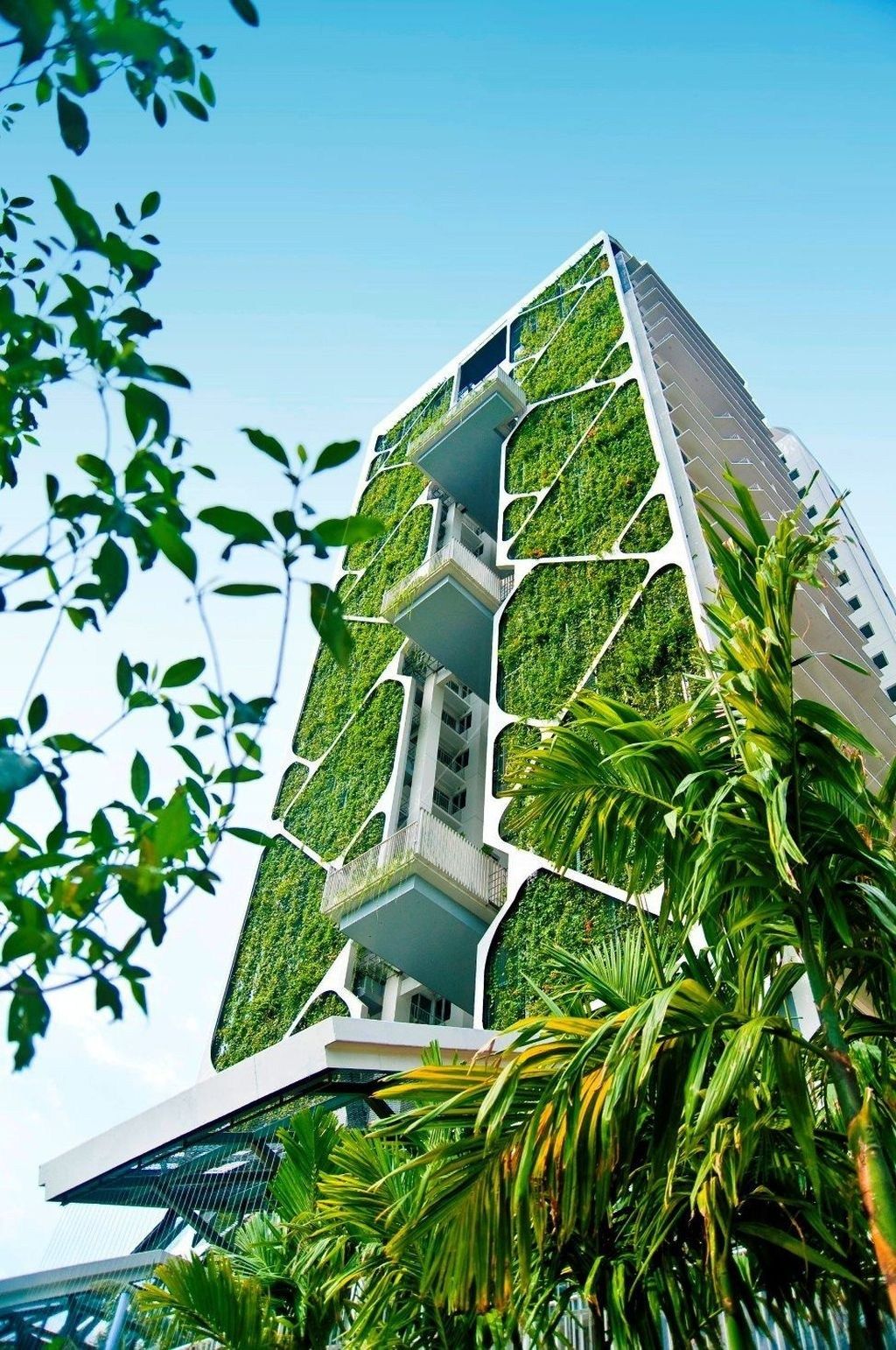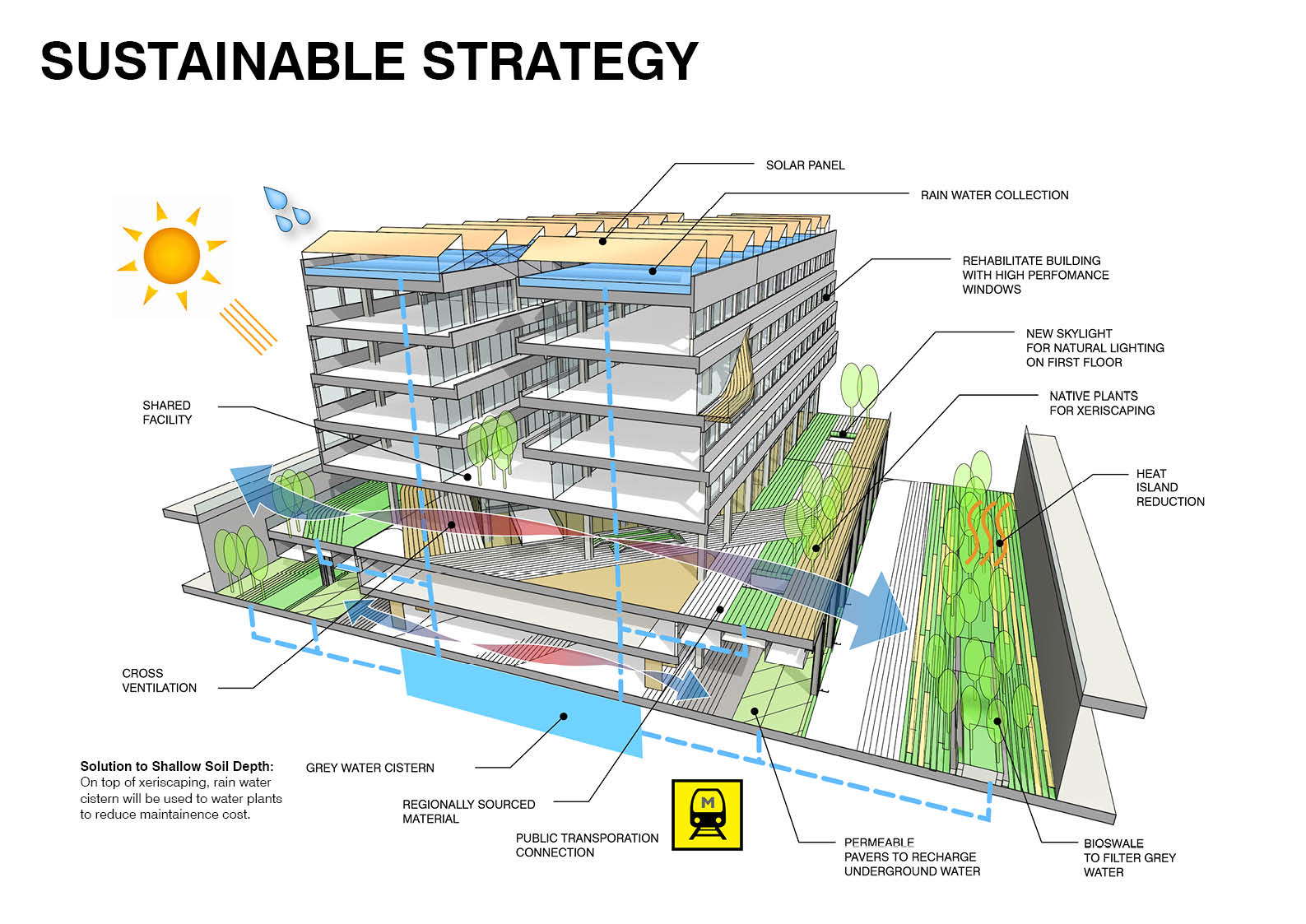Sustainable design is an integrated, holistic approach that positively impacts all phases of a building's life-cycle and encourages compromise and tradeoffs.
What is a sustainable design and construction statement?
With the right approach, a well written sustainability statement can ensure a smooth and successful passage through to approval. The aim of the report is to demonstrate how the developer will address specific local objectives from CO2 emissions and renewable energy targets to environmental issues.
What is meant by sustainable construction?
Sustainable construction means using recyclable and renewable materials in building projects and minimizing energy consumption and waste production. The primary goal of the sustainable construction method is to reduce its impact on our environment.
What is an example of sustainable design construction?
Sustainable construction technologies typically include mechanisms to lessen energy consumption. The construction of buildings with wood, for instance, is a sustainable construction technology as it has a lower embodied energy in comparison to those build of steel or concrete.
What are the three main principles of sustainable design construction?
Sustainable design principles aim to: Optimize site potential. Minimize non-renewable energy consumption and waste. Use environmentally preferable products.
How do architects make buildings sustainable?
Architects must consider the local climate, topography, and infrastructure when designing sustainable buildings. By incorporating locally sourced elements, such as natural materials and renewable energy sources, architects can reduce emissions and waste while creating a building tailored to its environment.



How can acoustics contribute to more sustainable building design? 🌲
— KP Acoustics Group (@KPacoustics) August 16, 2022
The key is in the choice of materials.
What do you think?#Sustainability#SustainableConstruction#Construction#Acoustics pic.twitter.com/FCj3GJvX6a
What is architects responsibility to sustainability?
The role of the architect in sustainability is to design buildings that are environmentally responsible, economically viable, and socially equitable. This requires a deep understanding of sustainable design principles, as well as an understanding of the local climate, culture, and context.
Frequently Asked Questions
What materials are sustainable for architecture?
- Cob. Cob, Eco Friendly Natural Building Material.
- Recycled Steel. Image by Chevanon Photography on Pexels.
- Sheep's Wool. Photo by Annie Spratt on Unsplash.
- Reclaimed , Recycled or Sustainable Wood. Reclaimed wood.
- Cork.
- Straw Bales.
- Bamboo.
- Recycled Plastic.
What is a degree in sustainable design?
About the Program
Sustainable Design implies making decisions at various scales of the built environment (buildings, communities, land use patterns, urban support systems) in ways that support environmental quality, social equity, and economic vitality.
What do sustainable designers do?
Sustainable design creates long-term solutions and helps societies ensure the well-being of their people and harmony with the environment for generations. Designers reduce waste by making products that are recyclable, compostable and even better - endlessly reusable.
What is the relationship between sustainable development and sustainable construction?
What Is Sustainable Construction? Sustainable construction aims to apply the principles of sustainable development to the construction industry. It involved developing buildings and structures that: Maximise the use of sustainable resources while causing less pollution and waste.
What is the importance of sustainability concept to the construction industry?
Sustainable construction is important for many reasons, including reducing greenhouse gas emissions, conserving resources, and improving the long-term durability of our built environment.
Why is technology so important to construction management?
Technology enables construction teams to make hypothetical changes to the project and see their impact in real-time to make cost-effective decisions. You can detect any potential errors that might affect the project.
What is sustainable housing design?
What Is Sustainable Housing? A sustainable home is built, operated, and maintained in ways that reduce the owner's carbon footprint and the impact of climate change. Modern technology and conscious practices formed many ideas for building more efficient homes, one of which could be ideal for you.
What does it mean for a house to be sustainable?
A sustainable home is one that is built or retrofitted in a way that conserves resources, optimizes energy and water use and that will last longer with quality systems.
What are examples of sustainable design?
There are examples of eco-design in all kinds of consumer goods, such as biodegradable furniture, recycled tableware, edible coffee cups and bamboo sunglasses or toothbrushes, as well as clothes and shoes made with plastic recovered from the ocean and ecological gold jewellery.
What is the most sustainable house shape?
However the fundamental rule is that a simple shape is much more sustainable than a complex shape. Complex shapes use more materials and they are not as energy efficient because they have more surface area. The shape that uses the least amount of materials is the circle.
What features are in a sustainable house?
- Energy Star-rated appliances. Homes with high-efficiency appliances are in demand because they offer enhanced performance with reduced energy usage.
- Programmable thermostats.
- Radiant floor heating.
- Solar panels.
- Recycled materials.
- Geothermal systems.
What is the concept of eco-design?
Eco-design considers environmental aspects at all stages of the product development process, striving for products which make the lowest possible environmental impact throughout the product life cycle.
What is the meaning of eco in design?
Eco design is both a principle and an approach. It consists of integrating environmental protection criteria over a service or a product's lifecycle. The main goal of eco design is to anticipate and minimize negative environmental impacts (of manufacturing, using and disposing of products).
FAQ
- What is the difference between eco-design and conventional design?
While traditional product development focuses primarily on factors such as usability, safety, cost, and quality, ecodesign emphasizes ecological factors. This means finding ways to reuse materials, while maximizing the safe use and value of the product.
- What is eco-design in architecture?
Building, Eco-Friendly. Sustainable design, also known as sustainable architecture or ecological design, is a school of thought that focuses on creating buildings that feature social and ecological sustainability.
- What is an example of eco-design?
There are examples of eco-design in all kinds of consumer goods, such as biodegradable furniture, recycled tableware, edible coffee cups and bamboo sunglasses or toothbrushes, as well as clothes and shoes made with plastic recovered from the ocean and ecological gold jewellery.
- How are some ways architects can design sustainable buildings?
- 9 Best Sustainable Architecture Design Ideas:
- Installing green roofs.
- Sustainable Design for the walls.
- Energy efficiency with Hydraulic dynamism.
- Eco-friendly interior design.
- Natural ventilation.
- Natural lights and LED systems to reduce energy use.
- Utilizing natural and recycled materials for building.
- Which architects are known for sustainable design?
- Peter Busby | Sustainable Architects
Peter has been a pioneer in educating people and demonstrating new techniques to use natural resources and energy more efficiently, his work focusing mainly on catering to people's needs.
- Who is the best architect designer?
- Top 10 best architects in the world
- Rafael Aranda.
- Carme Pigem.
- Ramón Vilalta.
- Carlos Ferrater.
- Oscar Tusquets.
- Benedetta Tagliabue.
- Santigo Calatrava.
- Carme Pinós.
- Who is the architect who builds with nature?
- Frank Lloyd Wright's greatest legacy is easily his modern homes built into nature. From more obvious examples like Fallingwater in Pennsylvania to the way organic shapes found in nature influenced nearly every design he dreamt up.
- What does an eco architect do?
Sustainable architects oversee the design and construction of buildings with a focus on the role a structure will play in its environment. Sustainable architects aim to use construction materials that won't contribute to landfills.
- What is the name of eco-friendly architecture?
Interchangeable with green architecture and ecodesign, sustainable architecture is a philosophical and design approach that reduces negative environmental impact while, to an extent, preserving natural resources, meeting the users' needs and improving the quality of life.
- What are the benefits of designing and building a green building?
Benefits of green buildings
Green buildings help reduce negative impacts on the natural environment by using less water, energy, and other natural resources; employing renewable energy sources and eco-friendly materials; and reducing emissions and other waste.
- What is the relationship between green building and construction?
Take the definition of “Green Building” and eliminate all the “extras” outside of the building process to get a definition of green construction: The construction of buildings to maximize employee health and productivity, using fewer resources, reducing waste and negative environmental impacts.
- What are the design criteria in order to be considered as a green building?
Enhancing Indoor Environmental Quality (IEQ)
According to the LEED IEQ guidelines, Indoor Air Quality (IAQ), thermal quality, and lighting quality are important factors for improving the overall IEQ of a building. Indoor Air Quality can be improved by reducing the volatile organic compounds (VOCs).
What is sustainable design and construction
| What is a construction method that benefits the environment? | Sustainable construction is the practice of creating a healthy environment that's based on ecological principles. According to Professor Charles J. Kibert, sustainable construction focuses on six principles: “conserve, reuse, recycle/renew, protect nature, create nontoxic and high quality.” |
| What are the advantages of green materials in construction? | Green building materials offer specific benefits to the building owner and building occupants: Reduced maintenance/replacement costs over the life of the building. Energy conservation. Improved occupant health and productivity. |
| What are the three main principles of sustainable construction? | Sustainable construction addresses these criteria through the following principles set by the conference: Minimize resource consumption (Conserve)by effective procurment systems and strategies. Maximize resource reuse (Reuse) Use renewable or recyclable resources (Renew/Recycle/Repurpose. |
| What are the principles of sustainable construction design? | Minimize non-renewable energy consumption and waste. Use environmentally preferable products. Protect and conserve water. Improve indoor air quality. |
| Which of the following are principles of sustainable construction? | What does sustainability in construction mean?
|
| What are the key concepts of sustainable construction? | Sustainable construction means using recyclable and renewable materials in building projects and minimizing energy consumption and waste production. |
| What are the six basic elements for sustainable building design? | The study reveals sixbasic elements to create a sustainable building design consist of site and land use, energy conservation, water management, sustainable materials, indoor environmental quality and innovation. All of these elements will educate people and function as a guidance to create a better building design. |
| What makes a building design sustainable? | Constructing a sustainable building means using appropriate materials in the most efficient way possible. This could mean using recycled materials, avoiding on-site construction waste and creating elements such as run-off to waterways. |
| What are the 7 principles of sustainable construction? | There are 7 principles of sustainable construction that feature in most sources:
|
| What is sustainable architecture in simple words? | Sustainable architecture is also referred to as green architecture or environmental architecture. It challenges architects to produce smart designs and use available technologies to ensure that structures generate minimal harmful effects to the ecosystem and the communities. |
| What are the differences between traditional building and sustainable building? | Conventional buildings have traditionally been built using bricks, concrete and steel; however, green buildings use materials that are earthly. This includes everything from timber, stone and straw (depending on the climate and region). |
| What does a sustainable architect or just an architect do? | Sustainable architects oversee the design and construction of buildings with a focus on the role a structure will play in its environment. Sustainable architects aim to use construction materials that won't contribute to landfills. |
- What is the difference between sustainable architecture and organic architecture?
The basic difference, if stated in simplistic terms between sustainable and organic architecture is that sustainable architecture aims to reduce the environmental impact as much as possible whereas organic architecture is one that mimics nature in its designs.
- What are the basic principles of sustainable architecture?
- While the definition of sustainable building design is ever changing, the National Institute of Building Sciences defines six fundamental principles.
- Optimize Site Potential.
- Optimize Energy Use.
- Protect and Conserve Water.
- Optimize Building Space and Material Use.
- Enhance Indoor Environmental Quality (IEQ)
- While the definition of sustainable building design is ever changing, the National Institute of Building Sciences defines six fundamental principles.
- What makes an energy efficient building?
An energy-efficient house has much higher insulation R-values than required by most local building codes. An R-value is the ability of a material to resist heat transfer, and the lower the value, the faster the heat loss.
- How do you know if a building is energy efficient?
- The ENERGY STAR score is a 1 to 100 score that demonstrates the energy efficiency of a building relative to similar buildings across the country. A score of 50 indicates the national average energy performance for that building type.
- What are some pros and cons of energy efficiency?
Pros include less use of energy and generally less greenhouse gases, while the cons are increased cost.
- What is the most efficient building design?
- A building designed with high R-value insulation in the walls and roof, and with insulated glass units with a low solar heat gain for example, will prevent too much heat from escaping the building during cold weather, and will prevent too much heat from entering the building during warm or hot weather.
- What is the first thing to consider when building an energy-efficient home?
While building an energy-efficient home, location, shape, and construction materials are prime considerations that will significantly influence the heating and cooling requirements. The maximum use of passive solar energy gain in winters and reduction of the heat gain during summers is the ideal scenario.
- What is the design stage of the construction process?
There are normally four different steps within the design stage and they include programming and feasibility, schematic design, design development, and contract documents. During the programming and feasibility step, each of the objectives and goals of the project has to be outlined.
- What are the four fundamental stages of the construction management process after the design stage?
The four fundamental stages of the construction management process are pre-construction, procurement, construction, and post-construction.
- What is phased construction?
Phased construction is where a project is broken down into smaller projects, and phases are carried out over months or even years. It is a preferred approach to a project where there could be financial restrictions, a risk to income or high levels of complexity.
- In which project phase does the production of drawing and specification occur?
During the schematic design stage, the architect produces a number of drawings embodying different directions the project could take. From these drawings, one is chosen to move forward with. Once a final schematic design has been chosen, the design development stage begins.
- What are the 4 stages of design?
- Four Stages of Design Thinking
- Clarify. The clarification stage involves observing and framing findings.
- Ideate. With your problem statement or question defined, you can use observations to think of potential solutions.
- Develop. The third stage focuses on developing ideas from the ideation phase.
- Implement.
- Four Stages of Design Thinking

